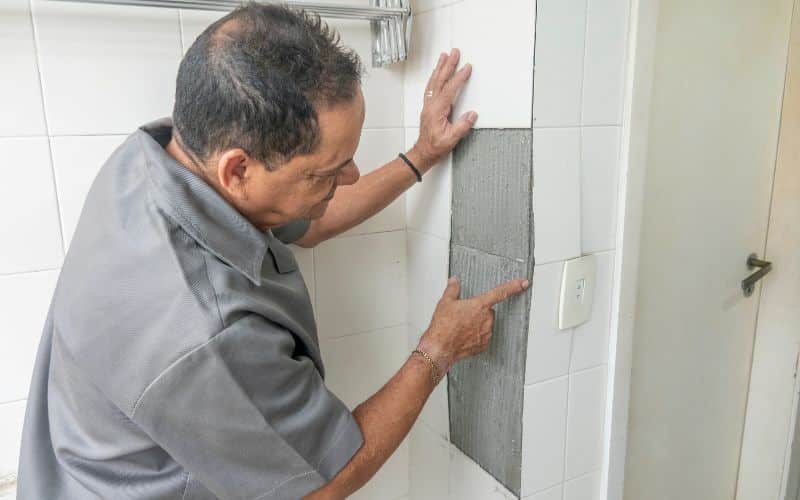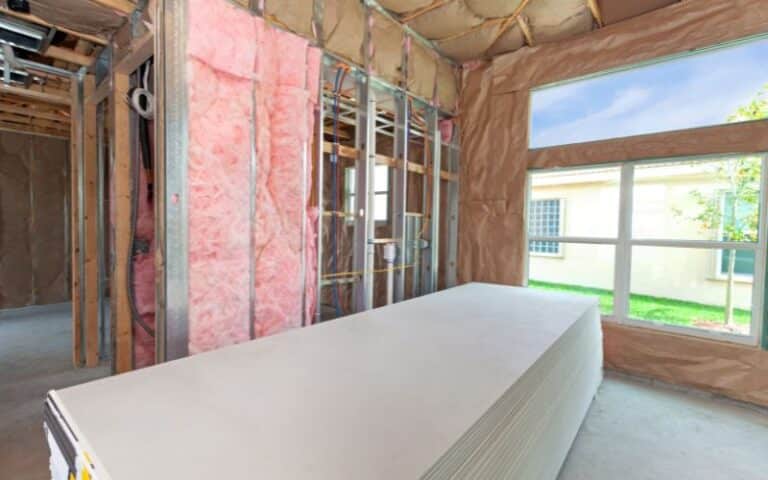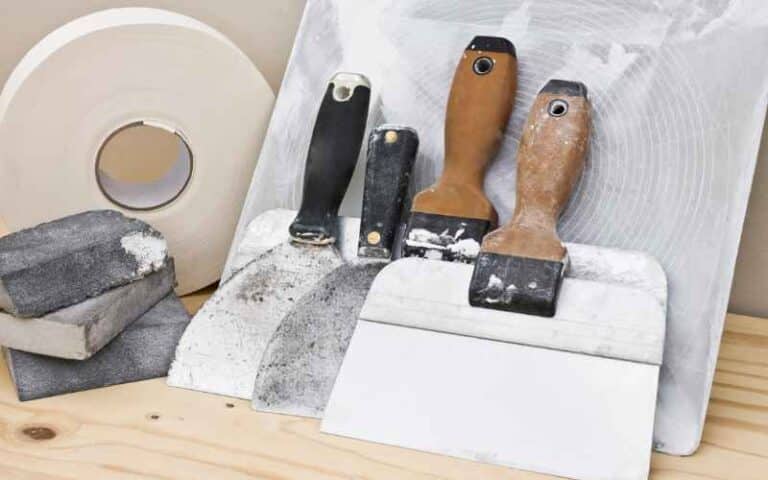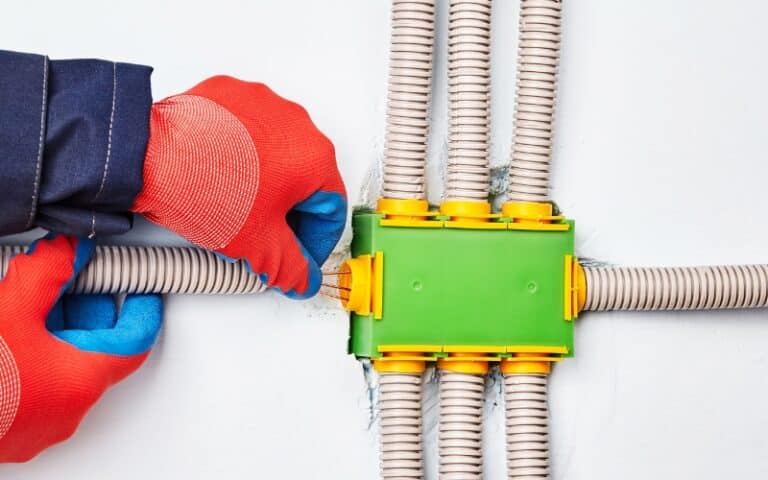Drywall is a popular building material due to its low cost and ease of installation. However, it is not uncommon for drywall to develop flaws, such as bowing with time.
Excess water in the area is the most typical cause. The water could come from flooding or something as minor as humidity.
Poor installation techniques or the wall frame bowing under the drywall could also cause this. but how do you fix this problem?
The most effective way to fix a bow in drywall is to replace it. Firstly, locate the source of the problem and attend to it to prevent it from happening again. Next, cut out the portion of bad drywall and replace it with a new one. You can also decide to paint it.
In this article, you’ll find out why drywall bows, how to fix it, methods to prevent this from happening, and ways to remedy it even after painting.
Ready for a Drywall Quiz?
What Causes Drywall to Bow?

Several factors can cause drywall bowing. Below are some of the factors that cause the drywall to bow.
#1. Moisture Absorption
One of the biggest causes of drywall bowing is moisture ingress.
When the drywall gets excessive moisture through leakages or excessive humidity, it absorbs the moisture, causing it to expand and deform.
#2. Improper Installation
When you install your drywall wrongly, it can cause bowing over time. Here’s how it happens.
- If you incorrectly attach the drywall panels to the wall frame or if there are gaps between the panels, it can cause the drywall to become weak and eventually bow.
- Poor joint treatment, such as insufficient bonding, can lead to weak seams. This weakness can cause the drywall to bow at the joints over time.
- In locations with wide spans or severe loads, inadequate or incorrect use of supporting materials, such as drywall anchors or bracing, can cause bowing.
#3. Underlying Structural Problems
Issues with the structural integrity of the building might also cause the drywall to bow.
The underlying wall studs, floor joists, or support beams may not be able to support the drywall, which can cause bowing adequately.
The problem could be because there’s damage. It needs to be stronger or properly aligned.
Walls may move due to a building’s foundation settling or shifting over time. This movement can have an impact on the firmness of the drywall, which could cause bowing.
#4. Change in Temperature
Extreme temperature fluctuations can affect the dimensions of drywall and cause bowing.
When exposed to hot temperatures, the drywall expands. On the other hand, it contracts when exposed to cold temperatures.
The constant processes of expansion and contraction place wear and tear on the drywall and may cause it to bow.
How to Fix Drywall Bow (Step by Step)?
To fix the drywall bow, you would have to replace it, but before replacing it, ensure that the issue causing the drywall to bow is taken care of. If not, repairing it will not make any difference.
Here’s how to fix drywall bow
Step 1: Set Up the Area
- Remove any furniture, decorations, or obstructions from the area around the bowing drywall.
- Protect the floor from dust and debris by covering it with a cloth or plastic sheet.
- Protect yourself using proper safety equipment, such as safety glasses and a dust mask.
Step 2: Check the Extent of the Drywall Bow
- Check to confirm how bad the drywall is. Ascertain whether the problem is a small one you can quickly resolve or a bigger one that could need professional assistance.
Step 3: Determine and Address the Causes
- Before starting with the drywall repair, if the bowing is because of moisture infiltration, find and repair the source of the moisture. Ensure that your area is waterproof and dry.
Step 4: Release any pressure
- Use a utility knife to make a precise incision along the center of the bow to release the pressure it is under.
- Make a small V-shaped hole by an incision in the bow’s center. Don’t cut too deeply, as this could harm the wall beneath.
Step 5: Strengthen the Drywall
- You can insert metal or wooden shims into the V-shaped hole to give balance and prevent bowing.
- Place the shims evenly along the length of the holes.
Step 6: Screw the Drywall
- To reattach the bowed drywall to the wall frame, use drywall screws.
- Drive screws into the drywall, particularly to areas close to the bow’s edges.
- Make sure the screws are 6 to 8 inches apart.
Step 7: Apply Adhesives
- Apply adhesive over the area you just repaired using a drywall trowel or putty knife. Let the adhesive reach other areas to mix with the rest of the wall is also advisable.
- To make your work look seamless, feather the edges and smooth the compound.
Step 8: Sand and Finish
- When the adhesive has dried, smooth the area with fine-grit sandpaper to ensure it is flat with the surrounding drywall surface.
- Reapply the adhesive again and repeat the sanding process.
Step 9: Paint the Drywall
- Prime the area using a superior drywall primer.
- Apply paint the same color as the existing wall once the priming dries. Also, paint the surrounding drywall surface.
Regardless of the above steps, if you need help with what to do or if there are severe occurrences of drywall bowing, it is best to contact a professional drywall contractor.
After knowing how to fix bowed drywall, it is also important to understand why we need to fix bowed drywall.
Below is a table showing the advantages of fixing bowed drywall on time.
| Advantages | Description |
|---|---|
| Safety | Bowed drywall can result in sudden wall failure, threatening people’s safety. |
| Saves Cost | Early intervention could help you resolve the bowing with less time and money. |
| Prevents Mold Growth | Moisture accumulation can result in mold growth. |
| Aesthetics | Bowing drywall changes how your walls look, producing ugly waves or bulges. |
How Can I Prevent My Drywall from Bowing Out?
One of the causes of bowed drywall is incorrect installation. The most effective way to stop drywall from bowing out is with a quality installation.
You can’t cut corners if you want the drywall to be as durable as possible, so it is best always to employ the services of a professional when installing drywall.
It’s important to use the proper tape. Usually, experts use paper tape to seal the seams in drywall.
A fiberglass mesh tape is also available, but the paper tape is tougher and better at preventing cracks.
Another major cause of bowed drywall occurs when water touches it. To prevent this, frequently check your home for leaks from windows, roofing, or plumbing.
Repair any leaks to stop moisture from penetrating the drywall and causing expansion, distortion, and bowing.
You can use open windows or exhaust fans to ensure that bathrooms and kitchens, which tend to have high humidity levels, are well-ventilated.
Another way to prevent drywall from bowing out is by controlling and preventing sudden room temperature.
It is advisable to keep your home’s rooms at a constant temperature. Avoid abrupt and excessive changes, as they could cause the drywall to expand and shrink, which might result in bowing.
You can also insulate outside walls, reducing temperature fluctuations and preventing moisture from accumulating on the drywall surface.
Can You Fix the Bowed Drywall After Painting?
It can be upsetting to find bowed drywall after it has painting because it is more difficult to correct bent drywall after painting than it is to fix it beforehand.
There are certain methods you can take to try to fix the issue, depending on how severe the bowing is.
- Assess the fault; it might be best to consult a professional if it is a major issue. If the bowing is something you can fix, here’s what to do.
- Please make a small V-shaped cut with a utility knife along the middle of the bowing area and release the pressure causing it. Take care not to cut too deeply to protect the paint coat.
- Insert a metal or wooden shims into the cut to stabilize and lessen bowing. You might need to loosen or remove surrounding screws to insert the shims properly.
- After inserting the shims, apply joint compound or adhesives and smooth it over the drywall surface. Apply many light coats to blend in with the previously painted area.
- Use fine-grit sandpaper to sand the area once the joint compound is dry gently.
- Apply a primer to ensure the fresh paint will bond properly to the repaired area. Repaint the repaired area using paint that matches the existing wall’s color and texture after the primer is dry.
- While it’s essential to fix bent drywall, it’s also necessary to preserve the quality of your drywall and guard against any problems.
Below is a table showing some maintenance tips:
| Maintenance Tips | Description |
|---|---|
| Inspect your Drywall Occasionally | Check your drywall for any indications of cracks. |
| Respond Quickly to Water Leaks. | If you see any indications of water leaks or excessive moisture. |
| Reinforcement | Reduce the danger of bowing by utilizing additional reinforcement during installation. |






